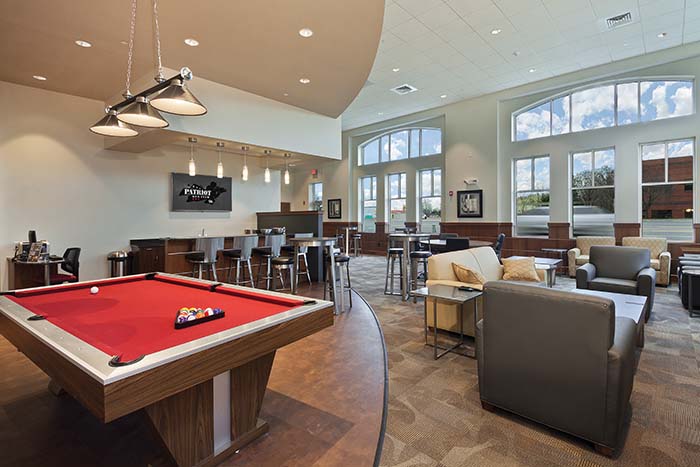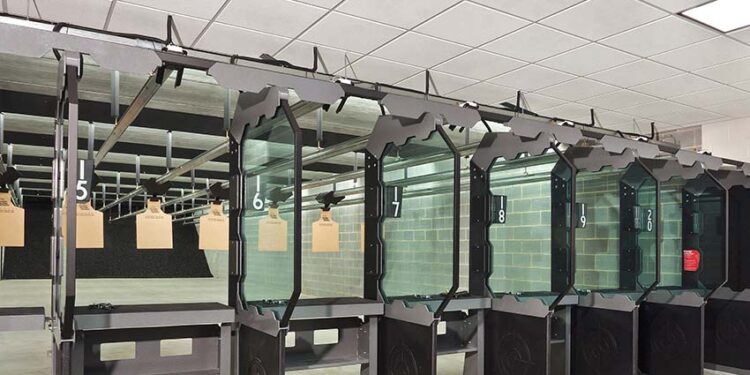By Gordon Meehl
Very few are lucky enough to step out of the confines of our houses, into the back yard and immediately be able to execute our range day game plan with in steps of our living room (safely). For the rest of us, we have to pack up our range bags and schlep our stuff to a local range.
I may be showing my age, but “back in the day” the options for where to shoot and what type of range were pretty limited. One choice was to take a long drive beyond city limits to a plot of land owned by a buddy or someplace where someone would charge a few bucks to shoot into a wall of stacked hay bales. Some were lucky enough to find an indoor range, usually an older stone or concrete building close to the airport or an abandoned industrial section of town.
Fast forward more than a few years. Now we enjoy the more “mainstream” popularity of shooting sports, innovative safety technologies and well thought out business/marketing plans; the choices for shooting locales are ever increasing. Ranges are no longer fringe businesses that are few and far between but rather genuine clubs with amenities that rival and often exceed those found at their more worldly cousins, the driving range. With a concentrated effort for your patronage and membership dues, both indoor and outdoor ranges are getting more creative in the benefits and amenities with which they entice you to open your wallet and throw rocks down range in their place of business.

Do an internet search for ranges in your area and chance are you’ll be faced with a screen filled with choices. To weed your way through your options you need to do a little introspection. What are your shooting goals? What do you want to learn? What firearms are you shooting?
The answers to those questions will help you develop a checklist of needs and wants that will help you navigate the sea of range options you have.
Regardless of whatever country club amenities that some ranges and shooting clubs offer, your choices will fall in one of two categories: an Indoor range or an outdoor range. If you’re not so lucky (or have the budget) as to be able to join a club that affords you access to both types of ranges, you’ll need to choose one over the other. That list of your needs and wants will help you determine how much weight each of the range types distinct pros and cons has for you.
Shooting at targets in wide open spaces is as old as gunpowder. It’s only fitting that we start our discussion with the upside and downside of shooting in the great wide open. Outdoor ranges can be as simple as a one bay clearing with a berm or as elaborate an entire shooting complex with multiple ranges, target presentations and target distances.
Outdoor ranges afford the shooter more space. With more space comes more flexibility. Most outdoor ranges have enough room to provide facilities for pistol, rifle and shotgun. This diversity provides opportunities for you to broaden your shooting experience and hone your skills on many different platforms. You can pack up your car with your cadre of firearms, arrive at the range and start your day in the pistol pit dinging steel with your 9mm. When that becomes mundane you can move on to dusting clays at the 5-stand. To finish out the day you can start slicing through the X at 600 yards with your .308.
The fresh air and open environment also attracts a wider variety of instructors. With space being less confined instructors can create a wider array of exercises to sharpen your skill set. Being outside, instructors can be more immersed in the exercises with their students. Outdoor ranges allow you to practice real world movement drills within an open space with your instructor moving with you and engaging you during the drill. It’s because of this flexibility and freedom that almost every major practical shooting event, from USPSA to 3gn, takes place outside.
Only at an outdoor range can you (if you desire) practice to shoot in adverse conditions. With practice and concentration most people will learn to put a bullet on target at 300-400 yards consistently on a windless sunny day. But it takes a little more skill to break paper in a tight group when it’s cold, windy and rainy. Shooting under less than ideal conditions hones your shooting skill to a finer point.
The plus points of an outdoor range for one shooter can sometimes be a minus point for another. Shooting in the elements is not for everyone. Shooting during the summer in Mississippi can be brutal when it’s 95 degrees with 98% humidity. Likewise it may put a damper on your fun shooting in Montana in January. Additionally, most outdoor ranges are not known for their amenities. A rental program at an outdoor range is an anomaly. I have only been to one outdoor range that has a “pro shop,” but to be fair it was a sporting clays club so the selection in the range shop was rather specific.
On the other end of the scale are the indoor ranges. The greatest change in shooting environments can be found in the world of indoor ranges. It used to be that finding a safe, well lit indoor range in a desirable location took Magellan-like exploration skills. With advancements in range technology, lead mitigation and an increase in demand, new indoor ranges are opening up in a variety of locations and neighborhood types. Shooters no longer have to resign themselves to shooting at “the only game in town”.
It’s estimated that by 2020 the indoor range business will be a Billion dollar industry segment (source: marketsandmarkets.com), that’ Billion with a capital B. The competition for your shooting dollar and a piece of that market share pie is fierce. Indoor ranges are offering increasingly posh amenities. It’s not uncommon in some of the more well appointed shooting galleries to find people coming to the range to socialize and hang out as much as they are coming to shoot.
Ranges such as Point Blank Range in Matthews, NC offer club members amenities like a members only lounge, big screen TV’s gaming stations for the kids, and a business center, as well private showers and lockers. In addition, club ranges like this offer special discounts on firearms, ammo, training and other purchases. Most indoor ranges now have a pro shop and on-site gunsmithing. A lot of the club ranges also offer shooting leagues and regular events. Here in America, we love competition.
I know you’re thinking, all that stuff is great, icing on the cake, but we want to make things go bang! What does the typical indoor range have over the typical outdoor range besides a lounge and showers? There’s plenty more mundane plusses of going to an indoor range. Let’s tackle the Benefits of an indoor range one at a time.
Indoor ranges almost always have a gun shop on site. If you need more ammo, it’s there. Tired of your current heater, take it to the manager and start negotiating a trade. The convenience of having a gun shop on site while you are shooting is immeasurable. At outdoor ranges running out of ammo, forgetting a critical part of your kit or or having your gun go down means the end of your day and a long trip to a gun shop (probably at the indoor range).
Getting out of the elements means you’re able to go shooting come rain or shine, hot or cold. You don’t have to stand in the wind and rain, trying to stop shivering long enough to send a rock down range. For new shooters a climate controlled, no wind environment helps them focus on the fundamentals instead of being distracted by the weather.
Other advantages include a diverse offering of rental guns. Being able to rent a wide variety of firearms helps buyers give guns they are considering a “test drive”. Head to head comparisons and trigger time on potential purchase leads to happier first time buyers who will have a positive introduction to the sport. A large rental cabinet also helps more experienced shooting refine their skills on various platforms and break the monotony of shooting the same platform day after day. Then there is the added attraction of ranges that offer machine gun rentals; here is a chance to see if you really, really like a certain type of MG before plunking down the big bucks and going through transfer time.
For all the benefits and upsides of shooting at an indoor range, there are some some negatives to contend with. Probably the biggest disadvantage to shooting at an indoor range is that for the most part you’re limited to pistol shooting. Some lanes maybe designated to rifle use, some even can handle a .50 BMG but the fact remains you’re distance is very limited and shooting a rifle at anything less than a football field away gets old, fast.
Since space is limited, ceilings are low and people shooting in lanes mere feet away from you, there are tight restrictions on how you use your pistol. Among other things many places don’t let you practice drawing and shooting, headshots on target are not permitted. Practicing anything but straight stationary shooting will earn you more than just the ire of the RO’s. Some indoor ranges restrict ammunition type, so your cheap surplus might not be permitted.
Whether you’re going to an indoor range or heading to the great outdoors; there is no real bad choice. The most important thing is that you’re shooting. Decide which type of range meets your needs, what you’re shooting and what your goals are then pack up your bag and get to the range.
| This article first appeared in Small Arms Review V20N7 (September 2016) |











